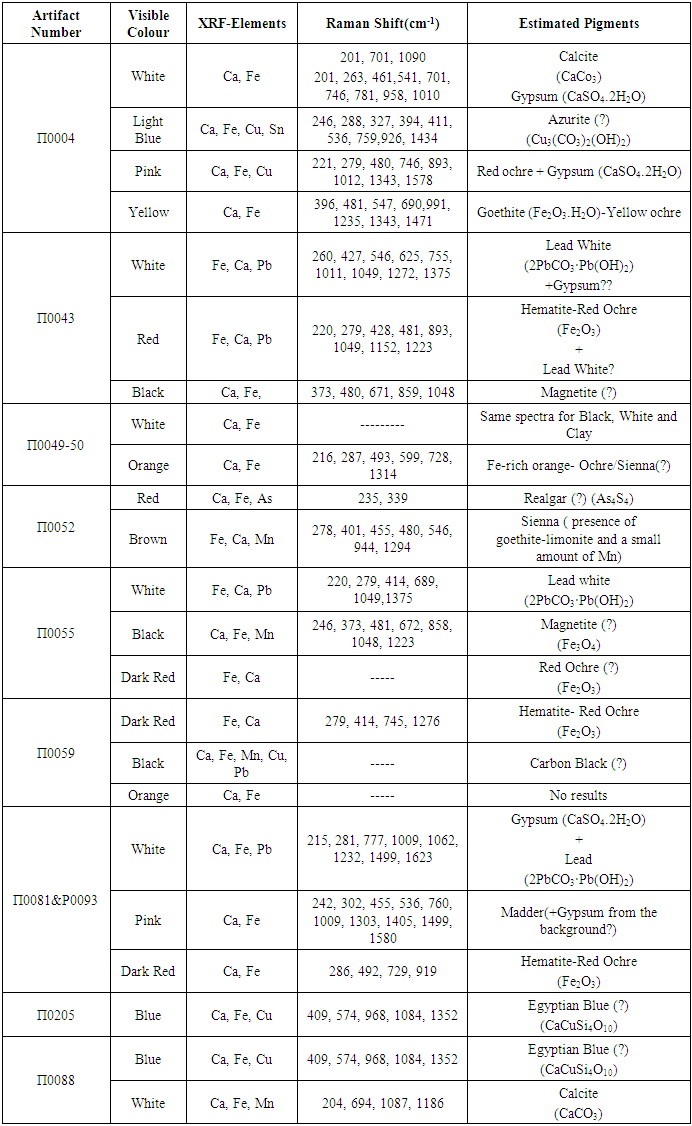-
Paper Information
- Next Paper
- Previous Paper
- Paper Submission
-
Journal Information
- About This Journal
- Editorial Board
- Current Issue
- Archive
- Author Guidelines
- Contact Us
Archaeology
p-ISSN: 2332-838X e-ISSN: 2332-841X
2021; 9(1): 34-40
doi:10.5923/j.archaeology.20210901.07

Pigments on Terracotta Figurines of the Hellenistic Period from Piraeus: Non-Destructive Chemical Analysis with XRF and Raman Spectroscopy
Maria Ntougka, Theodoros Ganetsos
Non-destructive Research Laboratory, University of West Attica, Aigaleo, Greece
Correspondence to: Maria Ntougka, Non-destructive Research Laboratory, University of West Attica, Aigaleo, Greece.
| Email: |  |
Copyright © 2021 The Author(s). Published by Scientific & Academic Publishing.
This work is licensed under the Creative Commons Attribution International License (CC BY).
http://creativecommons.org/licenses/by/4.0/

The rescue metro excavations in Piraeus, begun in 2012, revealed, in addition to architectural remains significant for housing design and development, a great number of mobile artifacts, among which included many terracotta Hellenistic figurines. This paper aims to present the preliminary results of a study, carried out for the purposes of my master’s thesis, on the materials used to decorate ten of those figurines. The objects are of well-known Hellenistic-era figurine types, such as deities, heroes, theatrical forms, and sitting figures, showing rich polychrome surfaces. Non-destructive, spectroscopic, portable XRF and Raman devices were employed to analyze these colours. Among the pigments identified are realgar, yellow ochre, red ochre, copper-based blue, lead white, gypsum, magnetite, and madder.
Keywords: Pireaus, Hellenistic period, Figurines, Pigments, XRF, Raman spectroscopy
Cite this paper: Maria Ntougka, Theodoros Ganetsos, Pigments on Terracotta Figurines of the Hellenistic Period from Piraeus: Non-Destructive Chemical Analysis with XRF and Raman Spectroscopy, Archaeology, Vol. 9 No. 1, 2021, pp. 34-40. doi: 10.5923/j.archaeology.20210901.07.
Article Outline
1. Introduction
- This work presents the preliminary results of the analysis on the decoration of ten fragmentary Hellenistic-era figurines coming from three separate areas in the center of Piraeus. The objects came to light during the rescue excavations carried out by Attica Metro S.A., under the authority of the Ephorate of Piraeus and Islands, as part of the expansion of Metro Line 3: Chaidari-Piraeus. More specifically, the figurines with artifact numbers Π0049-50, Π0052, Π0055, Π0059, Π0043, and Π0081 were found in Agios Konstantinos square, figurines Π0224, Π0205, and Π0088 came to light in the south section of Deligianni square, while the figurine Π0004 is from Pavlos Bakogiannis square (Figure 1).
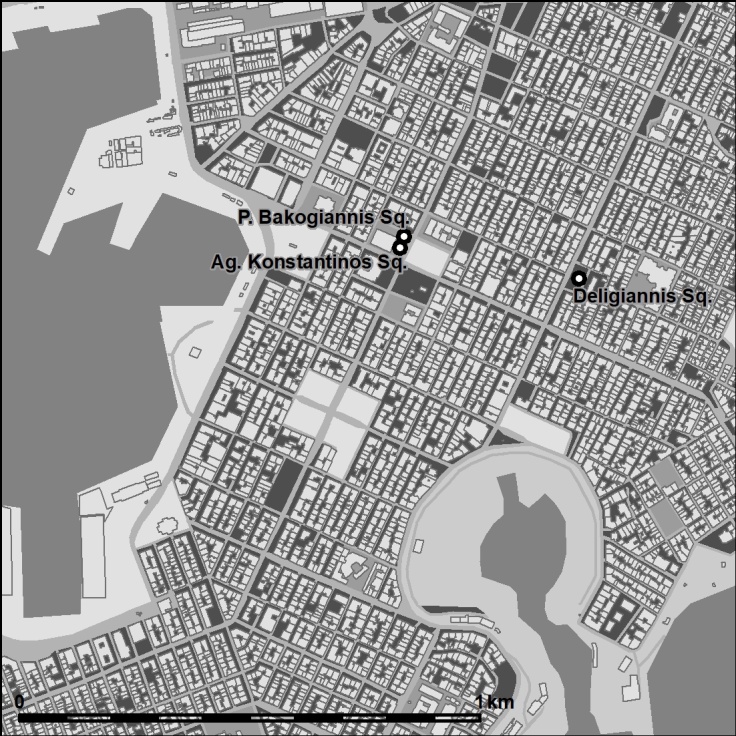 | Figure 1. Map of Piraeus with three excavation areas |
2. Methods and Limitations
- All measurements took place in the storeroom of the Ephorate of Pireaus, where the figurines were kept, and the following investigation of the spectra were performed in the laboratory of non-destructive techniques of the University of West Attica, under the supervision of Professor Th. Ganetsos. Due to the poor preservation of the samples and their decoration, when possible, multiple measurements of the same pigment from different spots were performed to cross-reference them. Moreover, spectra were collected from the unpainted interiors of the figurines to ensure that the results register pigment and not a clay spectrum.To detect the chemical elements in percentages (%) and in traces (ppm), a Skyray portable XRF, EDX Pocket III P730 was used, which provides an elemental detection range from S(16) to U(92) with a 40kV/50μΑ X-ray tube of Ag/W anode. Supplementing XRF spectroscopy, to identify the chemical composition of each pigment, a portable Rock Hound Delta Nu Raman Spectrometer, equipped with a near infrared 785nm laser source and an 8cm-1 resolution, was used. Raman spectra were received in the wavelengths of 200cm-1 to 2000cm-1. To ensure the correct Raman shift measurement and operation, calibration tests were conducted. The received Raman spectral data were further analyzed using Spectra Gryph optical spectroscopy software [11], and pigment identification was achieved by cross-referencing our specra to the ones of the international pigment databases Clark and Checker, and the Rruff mineral database [12,13,14]. Raman spectra are shown without smoothing or line fitting to convey the original picture seen during the measurements.Unfortunately, due to a technical problem, we could not transfer the data from the XRF device to the computer for further analysis with the spectroscopic software, so we left with the initial results.Βoth techniques are widely accepted for rapid, routine-level chemical characterization of artifacts with trustworthy results. Ιn this study we met some limitations and consequently inconclusive information, so that repetitious or additional measurements using different, more specialized instrumentations or techniques are required.During the XRF analysis Ca and Fe were present in every measurement. While the presence of these elements is likely explained as deriving from the underlying clay, still, it complicates the identification of certain pigments. A similarly puzzling situation is observable in the Raman data. Even though the Raman spectrometer let us focus the laser beam on pigment-rich areas in an effort to avoid impurities or other co-existing pigments, we note that a number of measurements do not correspond to the expected pigment, but to underlying clay. Just as important, the presence of fluorescence and noise in the spectra received due to impurities, organic constituents, or improper exposure of the pigment under the laser beam, made the identification in some cases almost impossible.
3. Results and Discussion
- In this study, pigments primarily were applied on a white substrate, which accounts for the presence of calcium where it is not expected, while in other instances, pigments were applied directly on the ceramic surface. The palette of the artists consisted of white, black, red, pink, yellow, brown, orange, and blue.
3.1. White
- White colour, made of three different types of white pigment, namely gypsum, calcite, and white lead, was used either as substrate, background, or mixed with other colourants to create less intense hues. In two cases there are strong indications that lead white was mixed with gypsum to create a more smooth surface (Table 1).
3.2. Black
- Black was visible on three of the objects. In two of the cases, a Fe-rich pigment presenting Raman bands at 246cm-1, 480cm-1 and 672cm-1, corresponds to magnetite (Fe3O4) vibration modes (Figure 2). This could be a mixture of magnetite and a carbon-based black pigment. In comparison to others in this study, XRF for Π0055 gave a relatively strong presence of Mn (Figure 3), (Table 1). This information leads us to identify the black hue as manganese black. Unfortunately, this assumption can not be confirmed from the received Raman spectrum. Further analysis is required. For the third sample, portable Raman failed to receive a meaningful spectrum due to the resolution of this instrument. While we lack evidence to identify this as any other black pigment, the fact remains that carbon black was the most commonly used black of all ages, and so we are left with this assertation (Table 1).
 | Figure 2. Blue line: Raman spectrum of black colour, sample Π0043. Orange line: Magnetite reference spectrum, RRUFF database |
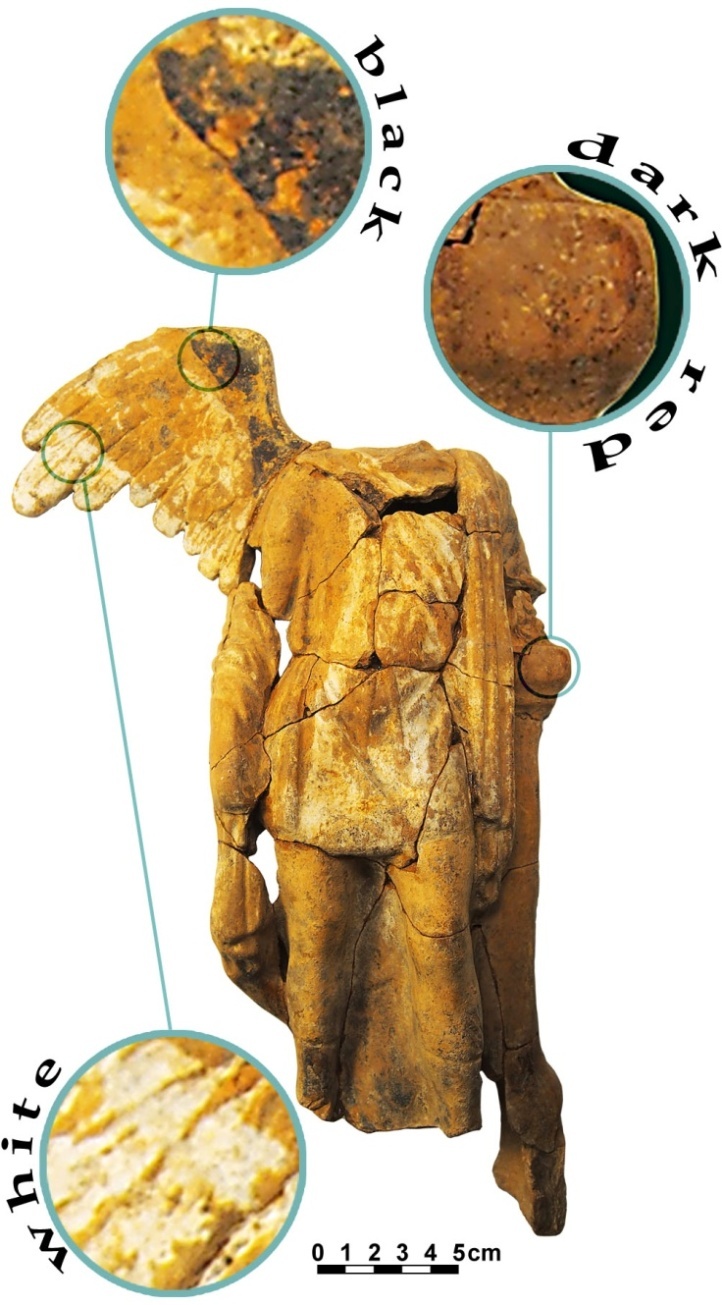 | Figure 3. Π0055. Scale 1:3, details magnified 300% |
3.3. Red
- For the red colour, different tonalities of red, from dark to intense, were exhibited. XRF spectra, collected on the red paint, show emission lines corresponding to iron (Fe) (Figure 4). Its presence is effectively confirmed by the recorded Raman spectral bands characteristic to hematite (Table 1), identifying the pigment as red ochre. Red ochre was used to introduce dark to intense red, or it was mixed with a calcite compound to produce pink. In only one case, on a more “elaborate” figurine, with a vivid red, applied to represent the lips, realgar was detected (Figure 5). The hue was identified as realgar because of the presence of the element As. However, we may strongly dispute the XRF results, since the apparatus in use was not able to detect Hg, and so, the excitation peaks Ka, Kb of As are likely to refer instead to the La and Lb of Hg respectively. Additionally, this idea is reinforced by the ancient texts, according to which, realgar, due to its instability when exposed to light, was not frequently used. When in need of an intense red, and mostly for more elaborate figurines, Cinnabar (HgS) was the preferable pigment, for which trade was established in the Mediterranean by the Hellenistic period [1]. The ancient scripts are confirmed by current research on ancient pigments [10,15,16,17]. Unfortunately in this particular case, Raman spectroscopy cannot supplement and clarify things, since the basic peaks for realgar and cinnabar are similar (Figure 6). Subsequent analysis with an XRF instrument with the ability to detect Hg is recommended.
 | Figure 4. Blue line: Raman spectrum of dark red colour, Π0059. Orange line: Hematite reference spectrum, RRUFF database |
 | Figure 5. Π0052. Scale 1:2 with details magnified 300% actual size |
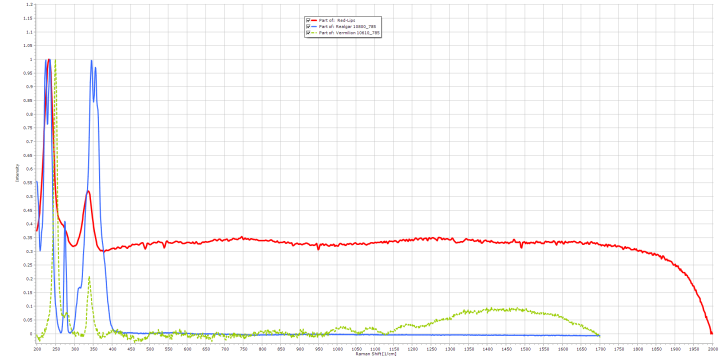 | Figure 6. Red line: Raman spectrum of red colour, Π0052. Blue line: Realgar reference spectrum. Green line: Vermillion (Cinnabar) reference spectrum, CHSOS database |
3.4. Pink
- Pink decorated two of the figurines. A mixture of red ochre and a calcite compound was used as pigment in one case, while the other showed the presence of madder and alizarin, which is the main ingredient for the manufacture of madder lake pigments [18]. The presence of a Raman peak at 1009cm-1 can be an indication of the presence of Gypsum, either derived from the backround or as a mixture with madder for the production of pink colour (Figure 7).
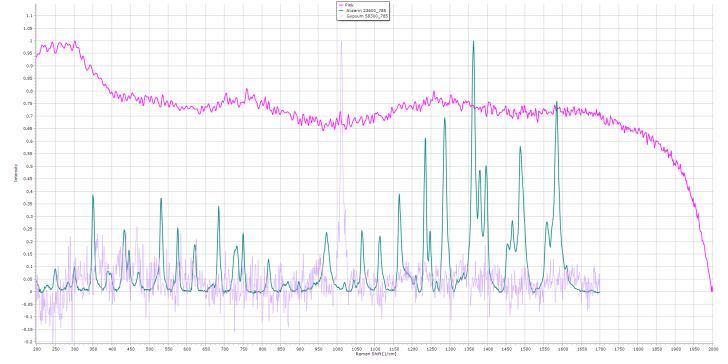 | Figure 7. Pink line: Raman spectrum of pink colour, Π0081. Green line: Alizarin reference spectrum. Purple line: Gypsum reference spectrum, CHSOS database |
3.5. Yellow
- Based on the presence of Fe and the characteristic Raman spectral bands of goethite, FeO(OH), the yellow colour is identified as yellow ochre, one of the “austere” pigments of Pliny’s palette (Table 1).
3.6. Brown
- The presence of characteristic goethite Raman bands, as well as the presence of Fe and, in smaller amounts the peresence of Mn, lead us to assume that sienna was used as a brown pigment (Table 1).
3.7. Orange
- Two of the figurines examined preserve orange and brownish-orange hues. The identification of the brownish-orange could not be completed since the Raman device registered clay sprectum and not a pigment. We presume the use of an earth pigment because of the presence of Fe, even though we understand that it is more likely that the Fe refers to the clay’s chemical composition and not to the pigment’s. Iron (Fe) is detected for the orange hue too, and by considering its Raman bands, we can assume that an ochre or sienna pigment was applied. Repetitive analysis is necessary for both samples.
3.8. Blue
- Blue pigment is identified on three figurines. All of them are copper based-blues and coupled with their Raman spectra, two out of three cases are identified as Egyptian blue, (Figures 8 and 9) and the third, a visibly lighter blue, is more likely identified as azurite (Table 1). Two facts are worth mentioning. Firstly, even though all of the colour spots were very clear and quite vivid, the Cu emission signal in all XRF spectra was weak, and secondly, in the pigments identified as Egyptian blue, tin (Sn) was not detected at all. This may suggest a change in recipe using pure copper rather than bronze scrap. Despite this, tin was detected as an element of the light blue pigment [19].
|
 | Figure 8. Π0205. Scale 1:1 with details magnified 300% actual size |
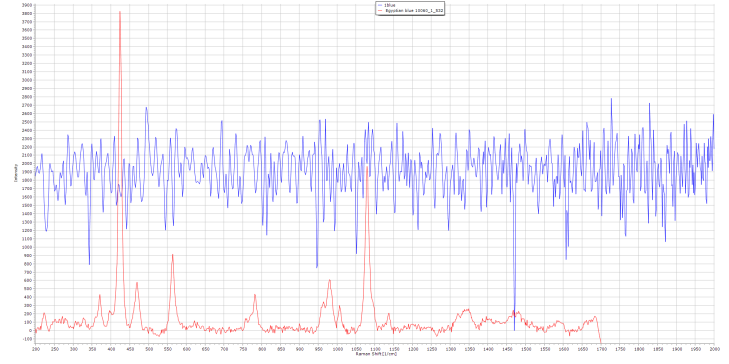 | Figure 9. Π0205, blue line, blue Raman spectra. Red line: Egyptian blue reference, CHSOS database |
4. Conclusions
- Herein we present the preliminary results on pigment identification with the aim to demonstrate the contribution of portable, non-invasive, spectroscopic techniques to archeology, conservation and cultural heritage as a whole. The colours identified in the artists’ palette were: white, black, red, pink, yellow, orange, brown, and blue. Specifically, calcium-based white was preferred as the substrate or in mixture with white lead to create a more smooth surface, and black was identified as magnetite and carbon-based pigment. Red ochre was the predominant red pigment with variations from dark red to pink, and only in one case red was identified as realgar. This identification is not final and further investigation would determine if it is actually a realgar pigment or cinnabar. Pink on one of the samples derives, more than likely, from an organic pigment, namely madder, and needs to be further examined by applying more suitable techniques. Iron oxides based on goethite were used to produce yellow, brown and, presumably orange colourantes, and copper-based pigments, Egyptian blue and azurite, were used for the blues. XRF and Raman techniques work side-by-side, efficiently complementing one another for pigment identification. With this duo, our initial results agree with the ancient scripts and with the current literature for the Hellenistic-era palette [15-21]. However, we should not stop there. Instead, we should push forward with more analytical and specialized techniques, such as SEM-EDS, XRD, FT- IR spectroscopy, including optical techniques, not only to verify our chemical identifications, but also to answer questions regarding binders, organic compounds, mixtures, provenience, and manufacturing practices.
ACKNOWLEDGEMENTS
- We thank the Director of the Ephorate of Antiquities of Piraeus and Islands, Stella Chrisoulaki for kindly allowing the study of this material.
 Abstract
Abstract Reference
Reference Full-Text PDF
Full-Text PDF Full-text HTML
Full-text HTML